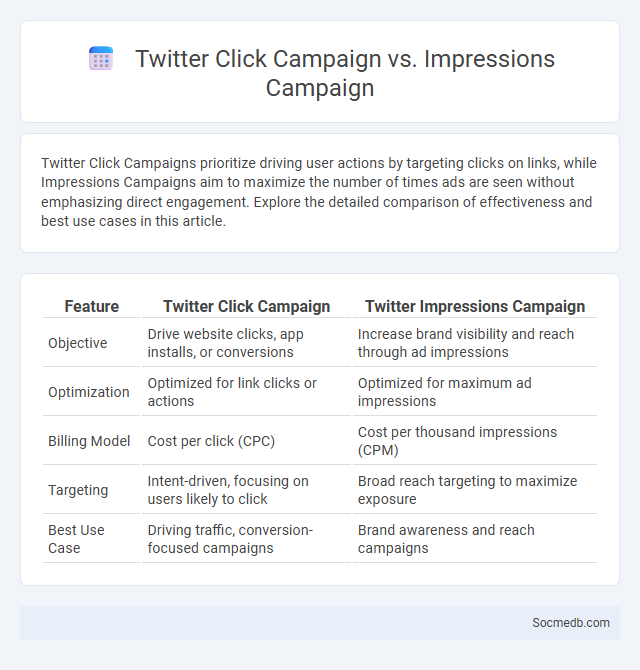
Photo illustration: Twitter Click Campaign vs Impressions Campaign
Twitter Click Campaigns prioritize driving user actions by targeting clicks on links, while Impressions Campaigns aim to maximize the number of times ads are seen without emphasizing direct engagement. Explore the detailed comparison of effectiveness and best use cases in this article.
Table of Comparison
| Feature | Twitter Click Campaign | Twitter Impressions Campaign |
|---|---|---|
| Objective | Drive website clicks, app installs, or conversions | Increase brand visibility and reach through ad impressions |
| Optimization | Optimized for link clicks or actions | Optimized for maximum ad impressions |
| Billing Model | Cost per click (CPC) | Cost per thousand impressions (CPM) |
| Targeting | Intent-driven, focusing on users likely to click | Broad reach targeting to maximize exposure |
| Best Use Case | Driving traffic, conversion-focused campaigns | Brand awareness and reach campaigns |
Introduction to Twitter Advertising Campaign Types
Twitter advertising campaign types include Awareness campaigns designed to increase brand recognition, Engagement campaigns aimed at boosting interactions such as likes, retweets, and replies, and Follower campaigns that grow an audience by attracting new followers. Conversion campaigns focus on driving specific actions like website visits, app installs, or purchases, while Video View campaigns enhance video engagement metrics. Each campaign type leverages Twitter's targeting options, including demographics, interests, and behavior, to maximize ad performance and meet marketing objectives.
What is a Twitter Click Campaign?
A Twitter Click Campaign is a targeted advertising strategy designed to drive user engagement through clicks on promoted tweets, leading to increased website traffic or app downloads. These campaigns utilize Twitter's precise audience targeting features, such as demographics, interests, and behavior, to maximize click-through rates and conversion potential. Optimizing ad creatives and bidding strategies within Twitter's platform enhances campaign performance and delivers measurable ROI for marketers.
Key Features of Twitter Impressions Campaign
Twitter Impressions Campaigns maximize brand visibility by targeting specific audiences to increase tweet exposure and engagement. Key features include precise demographic and interest-based targeting, real-time analytics for performance tracking, and flexible budgeting options to optimize ad spend. These capabilities empower marketers to amplify message reach effectively while measuring impact through detailed impression metrics.
Understanding General Twitter Ad Campaigns
Understanding general Twitter ad campaigns involves targeting specific audiences based on interests, keywords, and demographics to maximize engagement and conversions. You can choose from various ad formats such as promoted tweets, video ads, and follower campaigns to suit your marketing goals. Monitoring analytics like impression rates, click-through rates, and conversion tracking helps optimize your campaign performance effectively.
Objectives: Clicks vs Impressions vs Ad Campaign Goals
Clicks measure user engagement by counting how many times an ad is tapped, directly indicating interest and potential conversion. Impressions track how often an ad is displayed, reflecting brand visibility but not user interaction or effectiveness. Aligning ad campaign goals--such as increasing website traffic, boosting brand awareness, or driving sales--with either clicks or impressions ensures optimized social media strategy and maximized return on investment.
Targeting Options: Audience Segmentation for Each Campaign Type
Social media platforms offer diverse targeting options that allow precise audience segmentation based on demographics, interests, behaviors, and location, enhancing the relevance of your campaigns. Custom Audiences enable retargeting previous visitors, while Lookalike Audiences help you expand reach by targeting users similar to your best customers. For each campaign type--awareness, engagement, or conversion--leveraging these audience segments ensures your message reaches the most responsive users, maximizing ROI.
Budgeting and Bidding Strategies Compared
Effective budgeting and bidding strategies on social media platforms significantly impact campaign success by balancing cost-efficiency and ad reach. Manual bidding grants You precise control over maximum bids per ad auction, optimizing budget allocation for high-priority conversions, while automatic bidding leverages algorithmic adjustments to maximize results within your set budget. Comparing these strategies reveals that manual bidding suits advertisers with specific cost targets, whereas automatic bidding adapts quickly to market fluctuations to improve overall ROI.
Performance Metrics: Assessing Success Across Campaigns
Performance metrics such as engagement rate, click-through rate (CTR), conversion rate, and reach provide critical insights for assessing the success of social media campaigns. Analyzing data from platforms like Facebook Insights, Instagram Analytics, and Twitter Analytics helps marketers identify which content resonates with their audience and optimize future strategies. Effective use of these metrics enables businesses to allocate budgets efficiently and improve overall campaign ROI.
Pros and Cons of Each Twitter Campaign Type
Twitter campaigns offer diverse benefits and drawbacks depending on the type. Promoted Tweets increase visibility and engagement but may feel intrusive to users, potentially lowering brand trust. Twitter Amplify enhances video content reach with premium placements, yet costs can escalate quickly, impacting your campaign budget efficiency.
Choosing the Best Campaign for Your Marketing Goals
Selecting the best social media campaign aligns closely with your specific marketing goals, whether increasing brand awareness, driving website traffic, or boosting sales conversions. Analyze platform demographics, engagement metrics, and content formats to ensure the campaign resonates with your target audience. Tailoring your strategy based on data-driven insights maximizes ROI and enhances overall campaign effectiveness.
 socmedb.com
socmedb.com